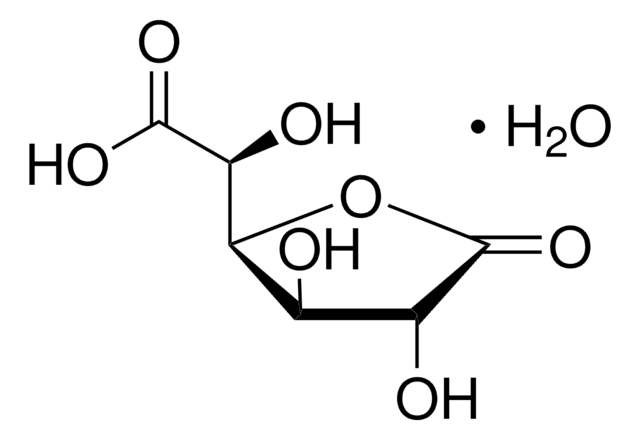G0501
β-Glucuronidase from bovine liver
Type B-10, ~10,000 units/mg solid
Synonym(s):
β-D-Glucuronide glucuronosohydrolase
Sign Into View Organizational & Contract Pricing
All Photos(1)
About This Item
Recommended Products
biological source
bovine liver
type
Type B-10
form
solid
specific activity
~10,000 units/mg solid
storage temp.
−20°C
Looking for similar products? Visit Product Comparison Guide
Application
β-glucuronidase is used as a reporter gene in GUS assays to monitor gene expression.
Biochem/physiol Actions
β-glucuronidase catalyzes the breakdown of complex carbohydrates. In humans it converts conjugated bilirubin into the unconjugated form, making bilirubin suitable for reabsorption.
Unit Definition
One Sigma or modified Fishman unit will liberate 1.0 μg of phenolphthalein from phenolphthalein glucuronide per hr at 37 °C at pH 5.0 (30 min assay).
Signal Word
Danger
Hazard Statements
Precautionary Statements
Hazard Classifications
Resp. Sens. 1 - Skin Sens. 1
Storage Class Code
13 - Non Combustible Solids
WGK
WGK 3
Flash Point(F)
Not applicable
Flash Point(C)
Not applicable
Personal Protective Equipment
dust mask type N95 (US), Eyeshields, Gloves
Certificates of Analysis (COA)
Search for Certificates of Analysis (COA) by entering the products Lot/Batch Number. Lot and Batch Numbers can be found on a product’s label following the words ‘Lot’ or ‘Batch’.
Already Own This Product?
Find documentation for the products that you have recently purchased in the Document Library.
Karel Allegaert et al.
Pediatric research, 63(6), 674-679 (2008-03-05)
To document determinants of O-demethylation in critically ill (pre)term neonates and infants, tramadol (M) and O-demethyl tramadol (M1) concentrations were quantified in eighty-six 24 h urine collections and 168 plasma samples. A significant correlation of urine log M/M1 (0.98, SD
Kenneth K C Bramwell et al.
The Journal of clinical investigation, 124(1), 311-320 (2013-12-18)
Lyme disease, caused by the spirochete Borrelia burgdorferi, is the most prevalent arthropod-borne illness in the United States and remains a clinical and social challenge. The spectrum of disease severity among infected patients suggests that host genetics contribute to pathogenic
Tracey B Tucker Zhou et al.
The Journal of biological chemistry, 288(51), 36302-36311 (2013-11-13)
Klotho (KL) is an age-regulating protein named after the Greek goddess who spins the thread of life. Mice deficient in KL are normal throughout development, but rapidly degenerate and display a variety of aging-associated abnormalities that eventually lead to decreased
Regina Goetz et al.
Nature reviews. Molecular cell biology, 14(3), 166-180 (2013-02-14)
Fibroblast growth factors (FGFs) mediate a broad range of functions in both the developing and adult organism. The accumulated wealth of structural information on the FGF signalling pathway has begun to unveil the underlying molecular mechanisms that modulate this system
Camilla A Thompson et al.
The Journal of biological chemistry, 288(14), 10093-10099 (2013-02-23)
Emerging evidence indicates that exosomes play a key role in tumor-host cross-talk and that exosome secretion, composition, and functional capacity are altered as tumors progress to an aggressive phenotype. However, little is known regarding the mechanisms that regulate these changes.
Our team of scientists has experience in all areas of research including Life Science, Material Science, Chemical Synthesis, Chromatography, Analytical and many others.
Contact Technical Service





